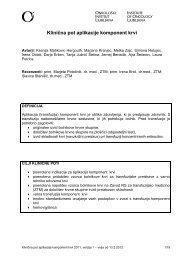Create successful ePaper yourself
Turn your PDF publications into a flip-book with our unique Google optimized e-Paper software.
Annexin-V apoptosis analysis of human malignant gliomaderived<br />
cell cultures treated with clomipramine<br />
hydrochloride<br />
K. Parker and G. J. Pilkington<br />
Cellular & Molecular Neuro-Oncology Group, School of Pharmacy & Biomedical Sciences, Institute of<br />
Biomedical & Biomolecular Sciences, University of Portsmouth, White Swan Road, Portsmouth PO1 2DT<br />
Background: Previous research in our laboratories has shown that Clomipramine<br />
Hydrochloride, a tricyclic antidepressant in use for over thirty years, selectively kills<br />
neoplastic cells in vitro whilst leaving normal brain cells unaffected (Rooprai et al Acta<br />
Neurochirurgica: 145: 145-148 2003). Moreover, we demonstrated that Clomipramine<br />
targets the mitochondria of tumour cells and triggers Caspase 3 mediated apoptosis<br />
(Daley et al Biochem Biophys Res Com 328: 623-632 2005; Meredith et al The FASEB<br />
Journal, published online May 2005). The purpose of this study was to evaluate whether<br />
a range of early passage cell cultures and established cell lines, derived from patients<br />
with malignant glioma, would display different sensitivities, with regard to apoptotic<br />
cell death, when exposed to Clomipramine.<br />
Methods: An Annexin-V flow cytometric assay was used to determine the mechanism<br />
of cell death, either necrosis or apoptosis, according to drug concentration and period<br />
of incubation. Cells grown to 90% confluence in 25cm 3 flasks were incubated with<br />
concentrations of Clomipramine from 20µM – 100µM, for up to 6 hours. Cells were<br />
harvested and resuspended in calcium binding buffer, which triggers translocation of<br />
calcium-regulated phosphatidylserine residues to the nuclear envelope, before removing<br />
500µl of the single cell suspension to a FACS tube. Controls used in the analysis were<br />
performed by omission of the drug incubation in one flask (positive control), and<br />
addition of 1uM staurosporine to another flask (negative control). Annexin-V FITC<br />
and propidium iodide were added to all tubes and incubated for 15 minutes at room<br />
temperature, in the dark. Subsequent to this, binding buffer was added to each tube<br />
and analysed using a BD FacsCalibur.<br />
Results: Of the five malignant gliomas tested, the two established cell lines had the<br />
lower apoptotic threshold, with a significantly higher percentage of apoptotic cells<br />
present at 60µM and above when compared to the control sample. The three early<br />
passage cultures, developed ‘in house’ from biopsy, had higher apoptotic thresholds,<br />
withstanding up to 100µM Clomipramine incubation for six hours. Normal human<br />
astrocytes were assayed in parallel, and showed that Clomipramine did not cause cell<br />
death at the concentrations tested.<br />
Conclusions: It may be possible, in a larger study, to predict individual patient response<br />
to Clomipramine using the Annexin-V assay, alongside Bcl-2 analysis and CYP (P450)<br />
gene metabolism testing, on the patient’s own tumour cells and blood plasma. The<br />
difference in sensitivities seen in this small study indicates the importance of analysing<br />
early passage cultures, which retain the original morphology and cellular heterogeneity<br />
to a greater extent, alongside established malignant glioma cell lines.<br />
Research on clomipramine in the authors’ laboratories was generously supported by<br />
grants from the Samantha Dickson Research Trust.<br />
p2799

















